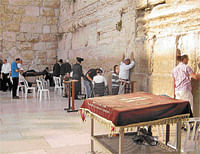
Naturally, curiosity was high in the air when a group of Indian journalists landed in the country for a week-long tour hosted by the American Jewish Committee. As we flew in from Istanbul, the seafront skyscrapers of Tel Aviv, Israel’s largest city and commercial centre, came into view. The Mediterranean was placid and yachts were sailing smoothly in the beautiful blue waters below. Within hours of touchdown, we were ushered into a traditional Israeli restaurant and treated to a welcome dinner-cum-orientation lecture by a former media advisor to the Israeli Prime Minister. The jetlag did not prevent many of us from savouring the variety that was served including chicken, several kinds of fish, bread and wine.
Country at war
Jerusalem may be the political capital of Israel, but Tel Aviv is a happening place with its night life, shopping malls and hi-tech industries. The first one was a sight-seeing tour in a helicopter. We flew over almost the entire stretch of south Israel within an hour-and-a-half. “Israel is actually smaller than Mizoram,’’ our guide Roley chipped in even as experts gave us the lowdown on Israel’s strategic situation.
As we passed the city of Beit Shemesh, we found ourselves at the foothills of the Judean Mountains. That was where David is believed to have battled Goliath and is understandably a haunt for archaeologists searching for remains of Biblical cities. One has to have a view from the top to realise that Israel is actually a chunk of desert made arable and habitable by sheer human effort and innovation. The Lachish plain is home for Israeli agricultural communities known as Kibbutzim.
But lest we forget, there is always a reminder that it is also a country constantly at war. We landed near a village called Sderot, which bore the brunt of rockets fired by Palestinian militants. And a drive to Nebbi Meri brought us within view of Gaza which has been out of bounds for tourists as Hamas, which administers the area does not recognise Israel. We flew back to Tel Aviv, this time along the cities that dot the Mediterranean shore like Ashdod and the ancient port of Jaffa. It was a great day and ended it with dinner hosted by the Indian Ambassador Navtej Singh at his residence.
A short visit to Haifa, the third largest city in Israel was the highlight of the third day of our tour. If you are in Haifa, you have to visit the picturesque Bahai temple and gardens on the slope of Mount Carmel. What makes the gardens a sight to behold are its 18 terraces with neatly trimmed trees. The gardens are one of the two great holy places for members of the Baha’i faith that originated in Persia in mid-19th century.
From Haifa, we proceeded to Jerusalem, a city steeped in history and significant for all the three Abrahamic religions. Interestingly, our arrival coincided with traffic restrictions for a gay parade that was being taken through the city, just another instance of the vibrant democracy that Israel is. To understand why Israel is a sacred land one has to travel to the Palestinian areas (old city) of Jerusalem. An outing in Bethlehem, West Bank, gave us a deep sense of the origin of Christianity.
Then there was the Western Wall or Wailing Wall, a holy site for Jews located on the foothills of Temple Mount. Like many other sites in Jerusalem, Temple Mount is sacred to Jews, Muslims and Christians. For Muslims, it is the site of Prophet Mohammed’s journey to heaven while Christians revere it as it is believed to be a place frequently visited by Jesus Christ. It is said that the common expression ‘walls have ears’ was originally said in reference to the Western Wall which has been one of the most sacred icons in Judaism for centuries.
Most visitors follow the Jewish custom of inserting a written petition to God into the cracks in the wall. We too did so. At the nearby Arab street, we shopped for mementoes, Jerusalem memorabilia and sweets. After a hurried dinner in a Moroccan restaurant, we sped off to watch the ‘night spectacular’ light and sound show at the Tower of David Museum. And what a spectacle it was! Amidst the archaeological remains in its courtyard and to the sound of original music, the story of Jerusalem unfolded through breathtaking, virtual reality images. The stones of the walls and structures kept fading into scenes and screened images enveloped viewers in an amazing multi-sensory experience.
As is the hallmark of Israel, there was soon a transition from the spectacular to the painful as we entered the Yad Vashem Holocaust Memorial along with a stream of visitors the next day. Within the walls of the building were letters, personal articles, photographs and audio-visual presentations of the biggest human carnage till date — the slaughter of six million jews by Nazis. The 1.5 million Jewish children who perished in the Holocaust are specially remembered in the nearby Children’s Memorial, an underground cavern in which the flickering flames of memorial candles are reflected in myriads of tiny lights within the prevailing darkness. A trip to the Dead Sea on the penultimate day helped us unwind.
The only thing ‘unpalatable’ about Israel was perhaps the food which may not quite suit South Indian tastes. But it was a small discomfort in an otherwise eye-opening and exhilarating experience.